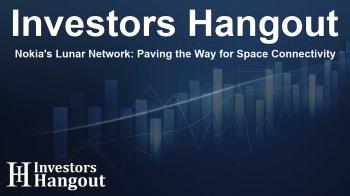Nokia's Lunar Network: Paving the Way for Space Connectivity

Nokia's Lunar Network: Paving the Way for Space Connectivity
Nokia has achieved a significant milestone as its cellular network system is now ready for deployment on the Moon. This exciting development follows the successful final integration of Nokia's Lunar Surface Communication System (LSCS) into Intuitive Machines' lunar lander for the upcoming IM-2 mission.
Email-Enabled Exploration
With the completion of these essential installations, Nokia is set to demonstrate the capabilities of cellular technology in lunar exploration. The IM-2 lander, named Athena, will venture to the lunar south pole, where it’s outfitted with systems to support the first-ever cellular network on the Moon.
Innovative Technology Installation
After extensive testing and evaluation conducted by the experts at Nokia Bell Labs, the LSCS, referred to as a "network in a box," was carefully installed on one of Athena’s upper carbon-composite panels. To ensure the system's safety during its journey to the Moon, various precautions were taken, including thermal isolation at each of the 14 mounting points. This design minimizes the effects of the extreme temperatures of space.
Enhancing Communication in Space
The LSCS is ingeniously tailored to handle surface connectivity between the lander and multiple vehicles. Utilizing the familiar 4G/LTE cellular technology employed by billions on Earth, Nokia Bell Labs has reconfigured this system to meet the specific demands of a lunar mission. Notably, this network is not just about basic connectivity; it's designed to facilitate high-definition video streaming and command-and-control communication, vital for mission success.
Data Relay and Resource Mapping
Intuitive Machines has exciting plans to relay data acquired from the LSCS back to Earth, capitalizing on its direct-to-Earth data transmission service. Moreover, two additional device modules from Nokia’s LSCS have been incorporated into lunar mobility vehicles: the Micro-Nova Hopper and the Mobile Autonomous Prospecting Platform (MAPP) rover. On landing, both vehicles will quickly utilize these modules to connect with Athena's cellular network, establishing an operational framework for future missions.
Contributions to Future Space Missions
One of the pivotal goals of this mission is to test new sensor instruments capable of identifying and mapping lunar resources, such as water ice. The Micro-Nova Hopper, designed to navigate shadowed lunar craters, will explore areas potentially rich in hydrogen, providing clues to ice deposits that are crucial for future exploration.
Exploration and Data Collection
The MAPP rover figures prominently into this mission as well. Upon descent onto the lunar surface, it is expected to emerge from Athena, extend its antennas, and tap into the Nokia cellular network. The MAPP rover will embark on a multi-day exploration journey of the Moon's south pole region, tasked with mapping the terrain while gathering essential environmental data.
Transformational Impact on Space Economy
CEO of Intuitive Machines, Steve Altemus, emphasizes the importance of delivering Nokia’s 4G/LTE system to the lunar surface, labeling it a groundbreaking moment for the commercialization of space. This initiative is not just about technology; it represents a pivotal step toward achieving sustainability in lunar missions. By effectively utilizing Nokia's capabilities for connecting surface assets and efficiently relaying that data back to Earth, the collaboration is steering toward defining the next generation of space exploration.
Looking Ahead: Future Missions
The launch of Intuitive Machines' Athena lander is targeted for later this upcoming year from NASA's Kennedy Space Center. This ambitious project represents not only a milestone in Nokia's endeavors but also a testament to the possibilities that innovative space technologies hold for unlocking resources and paving the way for future human presence on the Moon and beyond.
Frequently Asked Questions
What is the purpose of Nokia's Lunar Surface Communication System?
Nokia's LSCS is designed to establish the first cellular network on the Moon, facilitating communication for future lunar missions.
How does the LSCS adapt 4G/LTE technology for lunar conditions?
The LSCS has been reconfigured to meet the demands of the Moon's environment while maintaining reliable connectivity similar to terrestrial systems.
What are the roles of the Micro-Nova Hopper and MAPP rover?
Both vehicles are equipped with Nokia's device modules to establish connections to the lunar network, facilitating resource mapping and exploration.
What are the future applications of this technology?
This technology aims to support sustained human presence on the Moon and aid in the exploration and identification of resources critical for future missions.
Which companies are involved in the IM-2 mission?
The IM-2 mission involves collaborations between Nokia, Intuitive Machines, and NASA, highlighting a multifaceted approach to lunar exploration.
About The Author
Contact Olivia Taylor privately here. Or send an email with ATTN: Olivia Taylor as the subject to contact@investorshangout.com.
About Investors Hangout
Investors Hangout is a leading online stock forum for financial discussion and learning, offering a wide range of free tools and resources. It draws in traders of all levels, who exchange market knowledge, investigate trading tactics, and keep an eye on industry developments in real time. Featuring financial articles, stock message boards, quotes, charts, company profiles, and live news updates. Through cooperative learning and a wealth of informational resources, it helps users from novices creating their first portfolios to experts honing their techniques. Join Investors Hangout today: https://investorshangout.com/
The content of this article is based on factual, publicly available information and does not represent legal, financial, or investment advice. Investors Hangout does not offer financial advice, and the author is not a licensed financial advisor. Consult a qualified advisor before making any financial or investment decisions based on this article. This article should not be considered advice to purchase, sell, or hold any securities or other investments. If any of the material provided here is inaccurate, please contact us for corrections.

